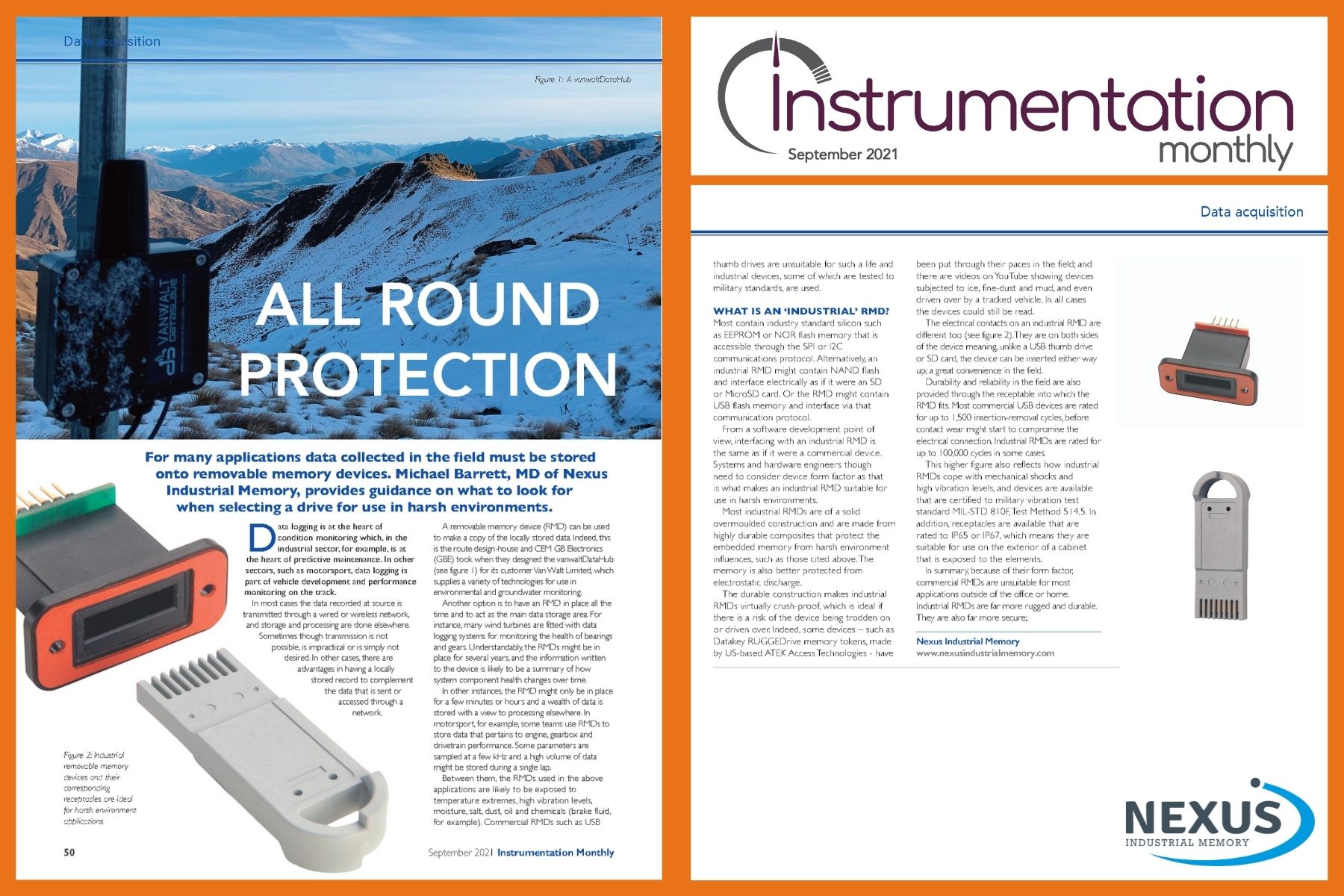View this article as a pdf.
For many applications data collected in the field must be stored onto removable memory devices. Michael Barrett, MD of Nexus Industrial Memory, provides guidance on what to look for when selecting a drive for use in harsh environments.
Data logging is at the heart of condition monitoring which, in the industrial sector, for example, is at the heart of predictive maintenance. In other sectors, such as motorsport, data logging is part of vehicle development and performance monitoring on the track.
In most cases the data recorded at source is transmitted through a wired or wireless network, and storage and processing are done elsewhere. Sometimes though transmission is not possible, is impractical or is simply not desired. In other cases, there are advantages in having a locally stored record to complement the data that is sent or accessed through a network.
A removable memory device (RMD) can be used to make a copy of the locally stored data. Indeed, this is the route design-house and CEM GB Electronics (GBE) took when they designed the vanwaltDataHub (see figure 1) for its customer Van Walt Limited, which supplies a variety of technologies for use in environmental and groundwater monitoring.
Another option is to have an RMD in place all the time and to act as the main data storage area. For instance, many wind turbines are fitted with data logging systems for monitoring the health of bearings and gears. Understandably, the RMDs might be in place for several years, and the information written to the device is likely to be a summary of how system component health changes over time.
In other instances, the RMD might only be in place for a few minutes or hours and a wealth of data is stored with a view to processing elsewhere. In motorsport, for example, some teams use RMDs to store data that pertains to engine, gearbox and drivetrain performance. Some parameters are sampled at a few kHz and a high volume of data might be stored during a single lap.
Between them, the RMDs used in the above applications are likely to be exposed to temperature extremes, high vibration levels, moisture, salt, dust, oil and chemicals (brake fluid, for example). Commercial RMDs such as USB thumb drives are unsuitable for such a life and industrial devices, some of which are tested to military standards, are used.
What is an ‘industrial’ RMD?
Most contain industry standard silicon such as EEPROM or NOR flash memory that is accessible through the SPI or I2C communications protocol. Alternatively, an industrial RMD might contain NAND flash and interface electrically as if it were an SD or MicroSD card. Or the RMD might contain USB flash memory and interface via that communication protocol.
From a software development point of view, interfacing with an industrial RMD is the same as if it were a commercial device. Systems and hardware engineers though need to consider device form factor as that is what makes an industrial RMD suitable for use in harsh environments.
Most industrial RMDs are of a solid overmoulded construction and are made from highly durable composites that protect the embedded memory from harsh environment influences, such as those cited above. The memory is also better protected from electrostatic discharge.
The durable construction makes industrial RMDs virtually crush-proof, which is ideal if there is a risk of the device being trodden on or driven over. Indeed, some devices – such as Datakey RUGGEDrive memory tokens, made by US-based ATEK Access Technologies – have been put through their paces in the field; and there are videos on YouTube showing devices subjected to ice, fine-dust and mud, and even driven over by a tracked vehicle. In all cases the devices could still be read.
The electrical contacts on an industrial RMD are different too (see figure 2). They are on both sides of the device meaning, unlike a USB thumb drive or SD card, the device can be inserted either way up; a great convenience in the field.
Durability and reliability in the field are also provided through the receptable into which the RMD fits. Most commercial USB devices are rated for up to 1,500 insertion-removal cycles, before contact wear might start to compromise the electrical connection. Industrial RMDs are rated for up to 100,000 cycles in some cases.
This higher figure also reflects how industrial RMDs cope with mechanical shocks and high vibration levels, and devices are available that are certified to military vibration test standard MIL-STD 810F, Test Method 514.5. In addition, receptacles are available that are rated to IP65 or IP67, which means they are suitable for use on the exterior of a cabinet that is exposed to the elements.
In summary, because of their form factor, commercial RMDs are unsuitable for most applications outside of the office or home. Industrial RMDs are far more rugged and durable. They are also far more secure; a subject we will gladly write about in a future issue of Instrumentation Monthly.

